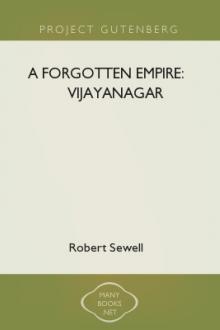A Forgotten Empire: Vijayanagar by Robert Sewell (short story to read TXT) 📕

- Author: Robert Sewell
- Performer: -
Book online «A Forgotten Empire: Vijayanagar by Robert Sewell (short story to read TXT) 📕». Author Robert Sewell
Caesaro Federici, an Italian traveller — or “Caesar Frederick,” as he is often called by the English — visited the place two years later, in 1567. He relates that, after the sack, when the allied Muhammadans returned to their own country, Tirumala Raya tried to re-populate the city, but failed, though some few people were induced to take up their abode there.
“The Citie of BEZENEGER is not altogether destroyed, yet the houses stand still, but emptie, and there is dwelling in them nothing, as is reported, but Tygres and other wild beasts.”[333]
The loot must have been enormous. Couto states that amongst other treasures was found a diamond as large as a hen’s egg, which was kept by the Adil Shah.[334]
Such was the fate of this great and magnificent city. It never recovered, but remained for ever a scene of desolation and ruin. At the present day the remains of the larger and more durable structures rear themselves from amongst the scanty cultivation carried on by petty farmers, dwellers in tiny villages scattered over the area once so populous. The mud huts which constituted the dwelling-places of by far the greater portion of the inhabitants have disappeared, and their materials overlie the rocky plain and form the support of a scanty and sparse vegetation. But the old water-channels remain, and by their aid the hollows and low ground have been converted into rich gardens and fields, bearing full crops of waving rice and sugar-cane. Vijayanagar has disappeared as a city, and a congeries of small hamlets with an industrious and contented population has taken its place.
Here my sketch of Vijayanagar history might well end, but I have thought it advisable to add a few notes on succeeding events.
Tirumala took up his abode at Penukonda, and shortly afterwards sent word to the Portuguese traders at Goa that he was in need of horses. A large number were accordingly delivered, when the despotic ruler dismissed the men to return to Goa as best they could without payment. “He licensed the Merchants to depart,” writes Federici, “without giving them anything for their Horses, which when the poore Men saw, they were desperate, and, as it were, mad with sorrow and griefe.” There was no authority left in the land, and the traveller had to stay in Vijayanagar seven months, “for it was necessarie to rest there until the wayes were clear of Theeves, which at that time ranged up and downe.” He had the greatest difficulty in making his way to Goa at all, for he and his companions were constantly seized by sets of marauders and made to pay heavy ransom for their liberty, and on one occasion they were attacked by dacoits and robbed.
Tirumala being now with King Sadasiva in Penukonda, the nobles of the empire began to throw off their allegiance, and one after another to proclaim their independence. The country was in a state of anarchy. The empire, just now so solid and compact, became disintegrated, and from this time forward it fell rapidly to decay.
To the Portuguese the change was of vital importance. Federici has left us the following note on their trade with Vijayanagar, which I extract from “Purchas’s Pilgrims:” —
“The Merchandize that went every yeere from Goa to Bezeneger were Arabian Horses, Velvets, Damaskes, and Sattens, Armesine335 of Portugall, and pieces of China, Saffron, and Scarletts; and from Bezeneger they had in Turkie for their commodities, Jewels and Pagodas,[336] which be Ducats of Gold; the Apparell that they use in Bezeneger is Velvet, Satten, Damaske, Scarlet, or white Bumbast cloth, according to the estate of the person, with long Hats on their heads called Colae,[337] &c.”
Sassetti, who was in India from 1578 to 1588, confirms the others as to Portuguese loss of trade on the ruin of the city: —
“The traffic was so large that it is impossible to imagine it; the place was immensely large; and it was inhabited by people rich, not with richness like ours, but with richness like that of the Crassi and the others of those old days…. And such merchandise! Diamonds, rubies, pearls … and besides all that, the horse trade. That alone produced a revenue in the city (Goa) of 120 to 150 thousand ducats, which now reaches only 6 thousand.”
Couto tells the same story:[338] —
“By this destruction of the kingdom of Bisnaga, India and our State were much shaken; for the bulk of the trade undertaken by all was for this kingdom, to which they carried horses, velvets, satins and other sorts of merchandize, by which they made great profits; and the Custom House of Goa suffered much in its Revenue, so that from that day till now the inhabitants of Goa began to live less well; for paizes and fine cloths were a trade of great importance for Persia and Portugal, and it then languished, and the gold pagodas, of which every year more than 500,000 were laden in the ships of the kingdom, were then worth 7 1/2 Tangas, and to day are worth 11 1/2, and similarly every kind of coin.”
Sassetti gives another reason, however, for the decay of Portuguese trade and influence at Goa, which cannot be passed over without notice. This was the terrible Inquisition. The fathers of the Church forbade the Hindus under terrible penalties the use of their own sacred books, and prevented them from all exercise of their religion. They destroyed their temples and mosques, and so harassed and interfered with the people that they abandoned the city in large numbers, refusing to remain any longer in a place where they had no liberty, and were liable to imprisonment, torture, and death if they worshipped after their own fashion the gods of their fathers.[339]
About this period, therefore (1567), the political condition of Southern India may be thus summed up: — The Muhammadans of the Dakhan were triumphant though still divided in interest, and their country was broken up into states each bitterly hostile to the other. The great empire of the south was sorely stricken, and its capital was for ever destroyed; the royal family were refugees at Pennakonda; King Sadasiva was still a prisoner; and Tirumala, the only survivor of the “three brethren which were tyrants,”[340] was governing the kingdom as well as he could. The nobles were angry and despondent, each one seeking to be free; and the Portuguese on the coast were languishing, with their trade irretrievably injured.
Firishtah summarises the events immediately succeeding the great battle in the following words: —
“The sultans, a few days after the battle, marched onwards into the country of Ramraaje as far as Anicondeh,[341] and the advanced troops penetrated to Beejanuggur, which they plundered, razed the chief buildings, and committed all manner of excess. When the depredations of the allies had destroyed all the country round, Venkatadri,[342] who had escaped from the battle to a distant fortress, sent humble entreaties of peace to the sultans, to whom he gave up all the places which his brothers had wrested from them; and the victors being satisfied, took leave of each other at Roijore (Raichur), and returned to their several dominions. The raaje of Beejanuggur since this battle has never recovered its ancient splendour; and the city itself has been so destroyed that it is now totally in ruins and uninhabited,[343] while the country has been seized by the zemindars (petty chiefs), each of whom hath assumed an independent power in his own district.”
In 1568 (so it is said) Tirumala murdered his sovereign, Sadasiva, and seized the throne for himself; but up to that time he seems to have recognised the unfortunate prince as his liege lord, as we know from four inscriptions at Vellore bearing a date corresponding to 5th February 1567 A.D.[344]
And thus began the third dynasty, if dynasty it can be appropriately called.
CHAPTER 16
The Third Dynasty
Genealogy — The Muhammadan States — Fall of Bankapur, Kondavid, Bellamkonda and Vinukonda — Haidarabad founded — Adoni under the Muhammadans — Subsequent history in brief.
The following is the genealogy of this third family.[345] They came apparently of the old royal stock, but their exact relationship to it has never been conclusively settled. The dates appended are the dates of inscriptions, not necessarily the dates of reigns.
The present Rajah of Anegundi, whose family name is Pampapati, and who resides on the old family estate as a zamindar under H.H. the Nizam of Haidarabad, has favoured me with a continuation of the family tree to the present day.
Ranga VI., or, as he is generally styled, Sri Ranga, is said to have been the youngest of three brothers, sons of Chinna Venkata III., Vira Venkatapati Raya being the eldest. Gopala, a junior member of the family, succeeded to the throne and adopted Ranga VI., who was thus a junior member of the eldest branch. The eldest brother of Ranga VI. was ousted.
I have no means of knowing whether this information is correct, but the succession of the eldest is given on the following page.
Pampapati Rajah is recognised by his Government as head of the family for two reasons: first and foremost, because the elder line is extinct and he was adopted by his sister Kuppamma, wife of Krishna Deva of the elder line; secondly, because his two elder brothers are said to have resigned their claims in his favour. The title of the present chief is “Sri Ranga Deva Raya.” Whether or no he has better title than his nephew, Kumara Raghava, need not here be discussed. The interest to the readers of this history lies in the fact that these two are the only surviving male descendants of the ancient royal house.
To revert to the history, which need only be shortly summarised since we have seen Vijayanagar destroyed and its territories in a state of political confusion and disturbance.
I omit altogether the alternate political combinations and dissolutions, the treacheries, quarrels, and fights of the various Muhammadan states after 1565, as unnecessary for our purpose and in order to avoid prolixity, summarising only a few matters which more particularly concern the territories formerly under the great Hindu Empire.
According to Golkonda accounts, a year after the great battle which resulted in the destruction of Vijayanagar, a general of the Qutb Shah, Raffat Khan Lari, ALIAS Malik Naib, marched against Rajahmundry, which was finally captured from the Hindus in A.D. 1571 — 72 (A.H. 979).
Shortly after his return to Bijapur (so says Firishtah), Ali Adil Shah moved again with an army towards Vijayanagar, but retired on the Ahmadnagar Sultan advancing to oppose him; and not long afterwards he made an ineffectual attempt to reduce Goa. Retiring from the





Comments (0)